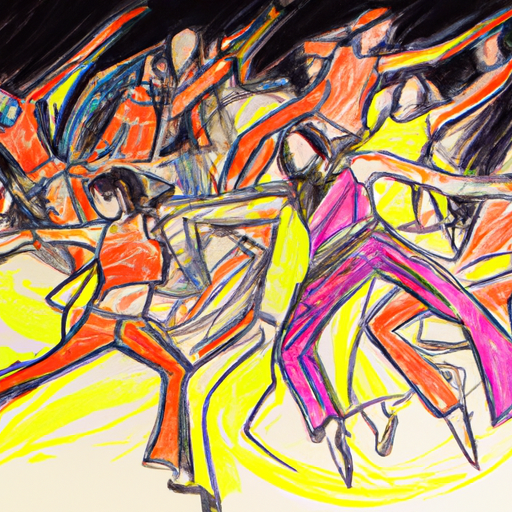In recent years, there has been a growing trend in the world of fitness and weight loss – the dance-based diet. This unique approach combines the joy of dancing with the benefits of a healthy, balanced diet to help individuals shed pounds and improve their overall well-being. But what exactly is the science behind this dance-based diet? How can it be diagnosed and treated? In this article, we will explore the diagnosis and treatment of the dance-based diet, as well as unlock the secrets to its symptoms and causes. Additionally, we will delve into the transformative power of dance and how it can revolutionize your health and well-being. So put on your dancing shoes and get ready to discover a whole new way to achieve your fitness goals.
1. "The Science Behind the Dance-Based Diet: Understanding the Diagnosis and Treatment"
The dance-based diet has gained significant popularity in recent years as a unique and enjoyable approach to staying fit and healthy. Combining the art of dance with a structured diet plan, this innovative concept provides a holistic approach to weight loss and overall well-being. In this section, we will delve into the science behind the dance-based diet, exploring its diagnosis and treatment methods.
Diagnosis of the dance-based diet begins with an evaluation of an individual’s current physical condition, including body mass index (BMI), muscle strength, and overall flexibility. This helps determine the specific dance routines and dietary requirements that will best suit the individual’s needs. Additionally, a thorough assessment of any underlying health conditions or injuries is crucial to ensure the safety and effectiveness of the diet.
Once diagnosed, the treatment plan for the dance-based diet involves a combination of dance exercises and a well-balanced diet. Dance routines are tailored to target specific muscle groups, improve cardiovascular endurance, and enhance coordination and balance. These exercises can range from high-intensity dance forms like Zumba or hip-hop to more low-impact options such as ballet or contemporary dance. The choice of dance style depends on individual preferences and physical capabilities.
In addition to the physical aspect, the dance-based diet emphasizes the importance of a healthy and nutritious eating plan. A diet rich in fruits, vegetables, lean proteins, and whole grains is essential to provide the necessary fuel for the body during dance workouts. Adequate hydration is also crucial to maintain optimal performance and prevent muscle cramps or fatigue.
The dance-based diet offers several benefits beyond weight loss. Regular dance exercises help improve cardiovascular health, increase flexibility, and strengthen muscles. It also promotes mental well-being by reducing stress, improving mood, and boosting self-confidence. Furthermore, the social aspect of dance classes provides a supportive community, fostering a sense of belonging and motivation.
However, it is important to note that the dance-based diet may not be suitable for everyone. Individuals with certain medical conditions or injuries should consult with a healthcare professional before starting this diet. Additionally, it is crucial to listen to your body and avoid overexertion, as pushing beyond your limits can lead to injuries.
In conclusion, the dance-based diet offers a unique and enjoyable approach to achieving a healthy lifestyle. By combining dance exercises with a well-balanced diet, it provides a holistic approach to weight loss and overall well-being. Understanding the diagnosis and treatment methods of this diet allows individuals to make informed decisions and embark on a journey towards a healthier and happier life.
2. "Unlocking the Secrets: Symptoms and Causes of the Dance-Based Diet"
Unlocking the Secrets: Symptoms and Causes of the Dance-Based Diet
The dance-based diet has gained significant popularity in recent years, attracting both dancers and non-dancers alike. This unique approach to dieting combines the physical demands of dance with a structured eating plan to promote weight loss and overall fitness. While it may seem like an appealing method to shed pounds and stay in shape, it is crucial to understand the symptoms and causes associated with this diet.
Symptoms of the dance-based diet can vary depending on the individual and their specific approach to this regimen. Some common symptoms may include excessive fatigue, muscle soreness, and a decreased immune system. Due to the rigorous physical activity involved, participants may experience heightened levels of exhaustion, leading to a lack of energy and motivation. The body may also struggle to recover properly, resulting in prolonged muscle soreness and an increased risk of injury. Additionally, the restrictive nature of this diet can lead to a deficiency in essential nutrients, weakening the immune system and making individuals more susceptible to illness.
The causes of these symptoms primarily stem from the intense physical demands placed on the body. Engaging in strenuous dance routines on a regular basis can lead to overtraining, which can cause fatigue and muscle soreness. Furthermore, the dance-based diet often involves severe caloric restrictions and limited food choices, which can result in nutrient deficiencies and compromised immune function.
It is important to note that the dance-based diet may not be suitable for everyone, especially those with pre-existing health conditions or those who are not accustomed to high-intensity exercise. It is crucial to consult with a healthcare professional or a registered dietitian before embarking on this diet to ensure its safety and appropriateness for individual needs.
In conclusion, the dance-based diet offers a unique and engaging approach to weight loss and fitness. However, it is essential to be aware of the symptoms and causes associated with this diet. Excessive fatigue, muscle soreness, and compromised immune function are common symptoms, primarily caused by the intense physical demands and restrictive nature of the diet. It is vital to prioritize individual health and consult with professionals to determine if this diet is suitable. Remember, a healthy and balanced approach to diet and exercise is always the key to long-term success.
3. "Getting Your Groove On: How Dance Can Transform Your Health and Well-being"
Dance has long been regarded as a form of artistic expression and entertainment. However, recent studies have shown that it offers numerous health benefits as well. From physical fitness to mental well-being, dance has the power to transform your overall health and enhance your quality of life.
One of the most evident benefits of dance is its ability to improve physical fitness. Engaging in dance requires a combination of strength, endurance, flexibility, and coordination. Whether it’s ballet, hip-hop, or salsa, each dance style challenges different muscle groups, leading to improved strength and toning of the body. Regular dance practice can also increase cardiovascular fitness, as it involves continuous movement that elevates the heart rate.
In addition to physical fitness, dance also contributes to mental well-being. When you dance, your brain releases endorphins, which are natural mood enhancers that reduce stress and anxiety. Dance provides an opportunity for self-expression, allowing individuals to channel their emotions through movement. This creative outlet can be therapeutic, helping to alleviate symptoms of depression and boosting self-confidence.
Furthermore, dance has been shown to enhance cognitive function. Learning complex dance routines requires concentration, memory recall, and problem-solving skills. Regularly engaging in dance can improve memory, attention span, and overall cognitive abilities, making it an excellent activity for individuals of all ages.
Apart from the physical and mental benefits, dance also promotes social interaction and emotional well-being. Joining a dance class or participating in group performances fosters a sense of community and camaraderie. This social support network can alleviate feelings of loneliness and isolation, improving overall emotional health.
The positive effects of dance on health and well-being are not limited to any particular age group. From children to older adults, everyone can reap the benefits of dance. In fact, dance has shown remarkable results in managing chronic conditions such as Parkinson’s disease and arthritis. The rhythmic movements and music of dance help improve balance, coordination, and motor skills, enhancing mobility and reducing the risk of falls.
It is important to note that dance-based diet should be approached in a balanced manner. While dance can be an enjoyable and effective form of exercise, it should be complemented by a nutritious diet to ensure optimal health. Eating a variety of fruits, vegetables, lean proteins, and whole grains will provide the necessary nutrients to support your dance practice.
In conclusion, dance is not just a recreational activity; it is a powerful tool for improving health and well-being. Its physical, mental, social, and emotional benefits make it a unique and enjoyable way to stay fit and enhance overall quality of life. So put on your dancing shoes, get your groove on, and let dance transform your health for the better.


